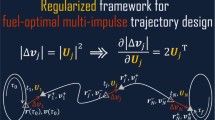Abstract
Solar sails have been investigated and explored since costs in space missions may be significantly reduced with the exploitation of a renewable energy source. This work investigates the dynamical effects on the phase space dynamics of a Solar Sail in the presence of the gravitational field of the Sun and Earth. For that, the Circular Restricted Three-Body Problem with the inclusion of the solar radiation pressure acceleration prescribes the time evolution of initial conditions settled in the Earth’s Hill region. In general, the dynamical system considered is conservative, in the sense of being area-preserving. However, only in the case of orthogonal incidence of the solar photons in the sail’s flat surface, the dynamics remain Hamiltonian, preserving a first integral of motion \(C_{J\beta }\). To provide an overview of the dynamics of this system, Poincaré sections are presented for the Hamiltonian case of the model and with the motion restricted to the plane. Given that, the qualitative behavior of trajectories is followed as a function of the first integral of motion \(C_{J\beta }\) and the sail lightness number \(\beta\), defined as the ratio between the solar radiation pressure acceleration and the gravitational acceleration of the Sun on the sail. Some remarkable dynamical features are reported. Possible applications and practical implications for trajectories design are discussed.









Similar content being viewed by others
Data availability
All data generated or analyzed during this study are included in this article in the form of figures.
References
A. Farrés, PhD thesis, University of Barcelona, Barcelona (2009). https://cercabib.ub.edu/permalink/34CSUC_UB/13d0big/alma991006045509706708
A. Farrés, A. Jorba, Artificial Equilibria in the RTBP for a Solar Sail and Applications. In: Gómez, G., Masdemont, J. (eds) Astrodynamics Network AstroNet-II. Astrophysics and Space Science Proceedings, 44, 73–89. Springer. (2016). https://doi.org/10.1007/978-3-319-23986-6_6
J. Van der Ha, Y. Mimasu, Y. Tsuda, O. Mori, J. Spacecr. Rock. 52, 958 (2015). https://doi.org/10.2514/1.A33158
C.R. McInnes, Solar Sailing (Springer, Berlin, 1999)
Y.A. Chernikov, Sov. Astron. 14, 176 (1970) https://ui.adsabs.harvard.edu/abs/1970SvA....14..176C
S. Shankaran, J.P. Sharma, B. Ishwar, Int. J. Eng. Sci. Technol. 3, 63 (2011). https://doi.org/10.4314/ijest.v3i2.68133
I. Todoran, Astrophys. Spec. Sci. 215, 237 (1994). https://doi.org/10.1007/BF00660081
V.G. Szebehely, Theory of Orbits (Academic Press, London, 1967)
C.D. Murray, S.F. Dermott, Solar System Dynamics (Cambridge University Press, Cambridge, 1999)
National Aeronautics and Space Administration (NASA). Planetary Fact Sheet - Metric. (2023). https://nssdc.gsfc.nasa.gov/planetary/factsheet/sunfact.html. Accessed 22 June 2023
A. Farrés, A. Jorba, Station keeping strategies for a solar sail in the solar system. In: Recent Advances in Celestial and Space Mechanics. Mathematics for Industry, vol 23. Springer, pp 83–115 (2016). https://doi.org/10.1007/978-3-319-27464-5_3
K.T. Alligood, T.D. Sauer, J.A. Yorke, Chaos (Springer, Berlin, 1996)
S.C. de Assis, M.O. Terra, Celest. Mech. Dyn. Astron. 120, 105 (2014). https://doi.org/10.1007/s10569-014-9567-2
S. C. de Assis, PhD thesis, Aeronautics Institute of Technology (ITA), São José dos Campos (2014). http://www.bdita.bibl.ita.br/
C. Simó, T. J. Stuchi, Physica D Nonlinear Phenomena. 140, 1 (2000). https://doi.org/10.1016/S0167-2789(99)00211-0
Acknowledgements
The authors wish to express their appreciation for the support provided by grant 88882.444503/2019-01 from the Coordination for the Improvement of Higher Education Personnel (CAPES), the National Institute for Space Research (INPE) and the Aeronautics Institute of Technology (ITA).
Author information
Authors and Affiliations
Corresponding author
Rights and permissions
Springer Nature or its licensor (e.g. a society or other partner) holds exclusive rights to this article under a publishing agreement with the author(s) or other rightsholder(s); author self-archiving of the accepted manuscript version of this article is solely governed by the terms of such publishing agreement and applicable law.
About this article
Cite this article
Braz, G.A., Terra, M.O. & de A. Prado, A.F.B. Solar sail dynamics in the Sun–Earth system: effects of SRP in the Earth Hill’s region. Eur. Phys. J. Spec. Top. 232, 3083–3093 (2023). https://doi.org/10.1140/epjs/s11734-023-01018-w
Received:
Accepted:
Published:
Issue Date:
DOI: https://doi.org/10.1140/epjs/s11734-023-01018-w




